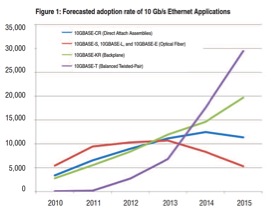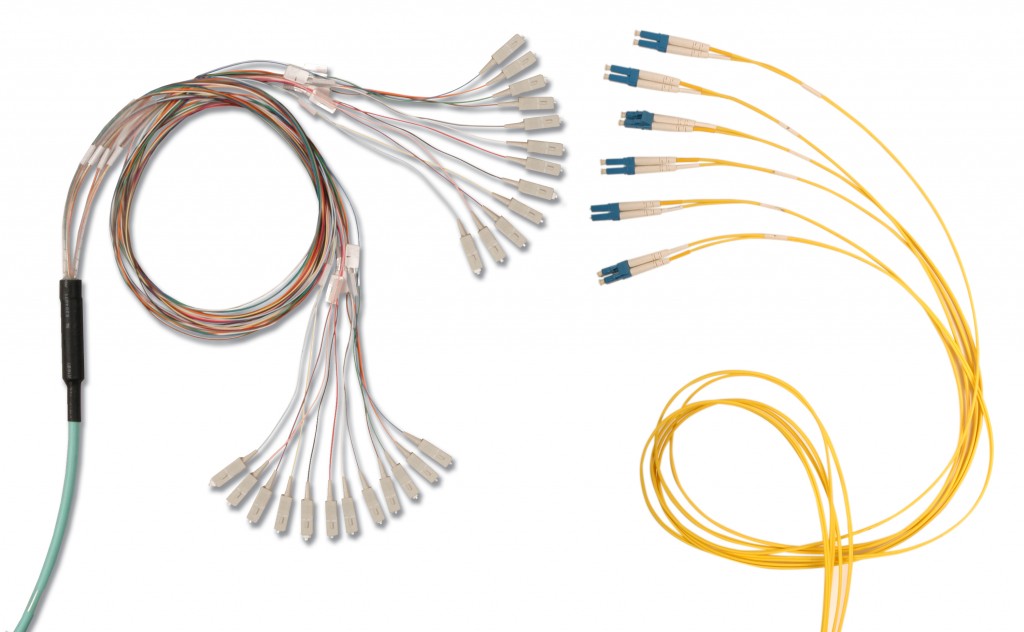“The Advantages of Using Siemon Shielded Cabling to Power Remote Network Devices” On-Demand Webinar Now Available
Watch the on-demand recording of the recent webinar now.
Ask Siemon | Careers | Blog
Data Centers, Intelligent Buildings and Enterprise LANs
Watch the on-demand recording of the recent webinar now.
According to PHY manufacturer Aquantia, 95% of all the major switch vendors now have a 10GBASE-T offering. These switches increase bandwidth and throughput in data centers and are significantly less power than the equivalent 10ea 1GbE ports. Power is now in line with fiber, providing a lower cost option that supports 1 an 10 GbE out of the same hardware. This provides additional savings for data centers. Intel (R) began shipping 10GBASE-T native on motherboards in 2011.
 For other benefits of 10GBASE-T including port savings and fewer switch purchases, please see Siemon whitepapers.
For other benefits of 10GBASE-T including port savings and fewer switch purchases, please see Siemon whitepapers.
Siemon DC Design services will be happy to provide assistance on data center layout options to help you utilize this new technology. It is important to remember that with current shipping hardware, approximately 1-1.5 Watts per port can be saved using 6A or 7A cabling under 30m. The right design can further your power savings while upgrading network links to support virtualization, cloud computing, and other high bandwidth applications.
When you put 10GBASE-T in the switch to server links, the backplane also needs to improve. While some manufacturers suggest using multiple 10GbE uplinks, some also use QSFP assemblies for 40GbE, and some are already supporting 100GbE. Visit Siemon SIS for supporting direct connect products.
A whitepaper from the Communications Cable and Connectivity Association’s (CCCA) data center committee is a guide for data center professionals and IT managers. The whitepaper examines the many factors to consider when evaluating top of rack (ToR) and structured cabling configurations, including the impact of those configurations on total management; scalability and upgrades; interoperability; equipment, maintenance and cabling costs; port utilization; power consumption and cooling requirements.
The Communications Cable and Connectivity Association’s (CCCA) newly formed data center committee has developed a whitepaper that is a guide for data center professionals and IT managers.
 The whitepaper, Navigating the Pros & Cons of Structured Cabling vs. Top of Rack in the Data Center, examines the many factors to consider when evaluating top of rack (ToR) and structured cabling configurations. Topics include the impact of those configurations on total management; scalability and upgrades; interoperability; equipment, maintenance and cabling costs; port utilization; power consumption and cooling requirements.
The whitepaper, Navigating the Pros & Cons of Structured Cabling vs. Top of Rack in the Data Center, examines the many factors to consider when evaluating top of rack (ToR) and structured cabling configurations. Topics include the impact of those configurations on total management; scalability and upgrades; interoperability; equipment, maintenance and cabling costs; port utilization; power consumption and cooling requirements.
This whitepaper is the first of many planned contributions from the data center committee. “The pace at which data center hardware and space configuration changes is daunting. CCCA recognized both a need and an opportunity to help guide data center cabling decisions by providing the latest studies, options and expert views from the industry’s leading cable and connectivity manufacturers,” states Executive Director Frank Peri. “As with our other working groups, the goal of the CCCA data center committee is to add our voice to the development of industry codes, standards and other important resources.”
The Data Center committee plans an active and ongoing global communications program using a variety of venues. “The global data center environment is dynamic and challenging for those designing the cabling network,” adds Bob Carlson of the Siemon Company and Chair of the new committee. “Cabling systems design and topology choices have a significant impact on server and port utilization, operating efficiencies and even energy consumption. The new committee strives to provide information and insights that are relevant globally to assist design professionals and end users to make well-informed cabling decisions.”
CCCA is comprised of leading manufacturers, distributors and material suppliers who are committed to serve as a major resource for well-researched, fact-based information on the technologies and issues vital to the structured cabling industry. For information updates on data center and other timely industry topics, visit the association’s website at http://www.cccassoc.org, sign up for the quarterly newsletter, check the Communications Cable & Connectivity LinkedIn group, and CCCA’s YouTube page.

Siemon expands its comprehensive line of fiber trunking solutions with XGLO RazorCore assemblies. Siemon’s RazorCore cables have a significantly reduced cable outside diameter (OD) for maximum space savings and air flow.

Siemon Razorcore fiber cable
Available in OM3 and OM4 laser-optimized multimode fiber and in singlemode fiber, XGLO RazorCore Assemblies provide an efficient, cost-effective alternative to individual field-terminated components. By combining the performance of factory termination with the reduced OD of Siemon’s RazorCore fiber, these new assemblies ensure both superior reliability and space utilization in data centers, Storage Area Networks (SANs) and Local Area Networks (LANs), while offering up to 75% faster deployment over traditional field termination. Compatible with all Siemon fiber enclosures, the new XGLO RazorCore assemblies feature an optional encapsulated protection sleeve with cable pulling eye to fully protect the fibers during installation.
“When selecting a fiber optic solution for our data centers, we wanted a solution that was fully scalable and allowed for the maximum density possible,” says customer Jean François Tremblay, Data Center Manager at Orange Business Services (a subsidiary of France Telecom), who recently installed XGLO RazorCore fiber trunking assemblies. “With Siemon’s reduced diameter RazorCore we were confident that the product could accommodate future growth both in space, due to the reductions in tray and pathway fill, and bandwidth, with the straight-forward upgrade path.”
“Siemon precision cable assemblies are 100% inspected for superior performance and enhance the installation method popular in today’s data centers. By expanding our offering with smaller-diameter RazorCore assemblies, our customers also obtain an average 50% size reduction compared to traditional assemblies,” says Kevin Stronkowsky, Fiber Optic Product Manager at Siemon. “This results in less cable tray fill, reduced pathway restrictions and better airflow—all of which support higher densities with improved efficiency and reduced cost.”
Warranted for 20 years, XGLO RazorCore Fiber Assemblies come with 900um simplex breakout, 2.0mm duplex breakout, simplex and duplex SC or LC connector types, as well as SC-LC hybrid options. The RoHS-compliant assemblies are available in a variety of jacket ratings, including Riser, Plenum and Low-Smoke, Zero Halogen. Available with 12, 24, 36 or 48 fiber counts, custom assemblies are easily created with Siemon’s flexible part number scheme to meet specific customer specifications and performance needs. Each XGLO RazorCore Assembly is designated for proper connector orientation, coded with a unique identification number and individually packaged with a dual shelf reel to protect connectivity during payout.
Learn more about XGLO RazorCore Fiber Trunking Assemblies.
More than century after eight-year old Virginia learned from the editor of the New York Sun that there was indeed a Santa Clause, IT managers and end users who recently learned about TIA’s latest “category 8” can rest assured that there is indeed an existing standards-based category 7A.
Yes, that’s right. After much debate, the Telecommunications Industry Association (TIA) TR-42.7 Copper Cabling Subcommittee recently adopted “category 8” as the nomenclature of their next generation balanced twisted-pair cabling system to eventually support 40 gigabits per second (Gb/s) in a two-connector model at some distance shorter than 100 meters (m). TIA moving consecutively from category 6A to category 8 has caused some confusion in the industry, and some are asking, “Is there a category 7?”
As was so eloquently put to little Virginia regarding the existence of Santa Clause when the editor responded, “Your little friends are wrong. They have been affected by the skepticism of a skeptical age,” the same holds true for category 7A. Despite what the skeptics say, this standards-based cabling system is here now and here to stay. Furthermore, it offers the benefit of interference-free cable sharing.
A Standards-Based Existence
Ratified in 2002 by the International Organization for Standardization (ISO) under ISO/IEC, 11801, 2nd edition, category 7 (class F) cabling, is a fully-shielded cable characterized up to a bandwidth of 600 megahertz (MHz). In 2010, Amendment 2 of ISO 11801 specified performance for category 7A (class FA) cabling. Also a fully-shielded S/FTP cable, category 7A offers an extended frequency bandwidth of up to 1000 MHz. Siemon’s TERA 1000 MHz cabling exceeds all ISO/IEC requirements for category 7A/class FA transmission performance.
Due to its fully shielded design, TERA 1000 MHz category 7A cable provides higher performance than unshielded twisted-pair (UTP) cabling. At higher frequencies, the use of individually shielded pairs virtually eliminates internal crosstalk between pairs and external cable-to-cable alien crosstalk, both along the cable run and at the connector. In fact, at 1000 MHz, TIA’s proposed performance limits for category 8 do not currently meet those specified for Siemon’s TERA category 7A cabling. Furthermore, the cable’s outer overall braid shield provides additional strength and a low impedance path to ground that provides superior resistance to electromagnetic interference and radio frequency interference (EMI/RFI).
ISO/IEC specifies two connector options for category 7 and 7A—an RJ-style connector as defined by IEC 60603-7-7 and a non RJ-style connector as defined by IEC 61073-3-104. The non RJ-style connector is based on Siemon’s TERA connector, which when installed as part of a complete TERA solution, delivers up to 1.2 GHz of bandwidth to exceed the bandwidth of category 7A/class FA specifications.
Unlike the RJ-style interface, the TERA connector offers a unique isolated quadrant design interface that that allows easy access to one or two pairs of a channel to better accommodate cable sharing—the practice of running more than one application over different pairs of a twisted-pair copper cable. Some skeptical designers and consultants are still concerned about specifying cable sharing because they are unsure of the Standards’ acceptance of the practice. The good news is that both TIA and ISO recognize and provide guidance on cable sharing implementation. In fact, ISO/IEC 15018 specifically recommends that cable sharing be considered when pathway space is limited and identifies the IEC 61073-3-104 TERA connector as the preferred interface for this application.
Doing Its Fair Share
Fully-shielded cabling systems like Siemon’s TERA category 7A system are much better at cable sharing than unshielded twisted-pair (UTP) cabling. That’s because the internal crosstalk coupling (both near-end and far-end) in UTP cabling systems makes it difficult for users to predict whether multiple applications can coexist in one cable. In fact, standards caution that when deciding which applications can share a UTP cable, users should be aware that crosstalk from applications operating in similar frequency bands can potentially interfere with one another. On the other hand, a TERA system guarantees that there is sufficient noise isolation between pairs to support multiple applications, or the multiple appearance of any one application, over a four-pair channel.
How specifically does cable sharing work? As with any category 7A cabling channel, all four shielded pairs are terminated to a single TERA outlet. However, in addition to accepting a 4-pair cord, the TERA connector can also support four 1-pair cords, two 2-pair cords, or a combination of the two—without the need for splitters or adapters. A single TERA outlet can therefore support multiple 1- and 2-pair low-speed applications or one 4-pair high-speed data application like 1000 Mb/s (1000BASE-T) or 10 Gb/s Ethernet (10GBASE-T). Cable sharing implementation practices are extremely flexible and support a wide range of configurations. The table below shows some typical 1- and 2-pair applications that can easily be supported with this cable sharing method.
By allowing various applications to be converged onto a single cable, the unused pairs that would be present if a 4-pair channel was dedicated to an application transmitting over just one, two, or three pairs are eliminated. TERA’s cable sharing capabilities therefore significantly reduces the number of cables required, subsequently reducing pathway costs and cable management complexity. For example, in a call center a single TERA connector can support four 1-pair analog phones for a cost savings in excess of 10 percent for materials and a 39 percent reduction in the total number of outlets.
Here Now and Here to Stay
While category 8 may now be on the TIA table, Siemon’s TERA category 7A is an existing standards-based system that provides the benefits of cable sharing, higher bandwidth capacity and EMI/RFI immunity. And ISO/IEC is already looking toward the future with this technology. The nearly finalized IEC 61076-3-104, 3rd edition, will extend the performance of the IEC 61073-3-104 Siemon TERA category 7A connector out to 2 GHz—the same frequency tentatively proposed for category 8.
Until the processing capabilities of a 40 Gb/s Ethernet application are finalized and more advanced and representative real-life analysis can be conducted, it is too early to guarantee 40 Gb/s support for any copper media. However, it does look as if Siemon’s fully-shielded category 7A TERA system with its unique connector design will ultimately provide some support for next generation speeds of 40 Gb/s while offering the innovative capability of cable sharing.
So yes, IT manager, there is a Category 7A.